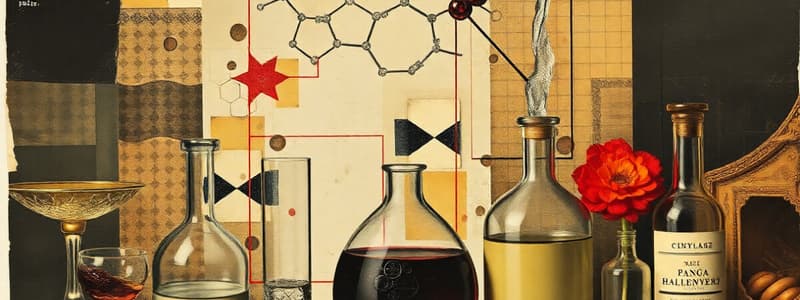Podcast
Questions and Answers
What is the main advantage of using thionyl chloride in the reaction with alcohols?
What is the main advantage of using thionyl chloride in the reaction with alcohols?
- It enhances the reaction rate significantly.
- It results in the formation of gaseous products that can be easily removed. (correct)
- It generates non-volatile by-products.
- It produces a more stable alkyl halide.
Which type of alcohol does not require a catalyst when reacting with concentrated HCl?
Which type of alcohol does not require a catalyst when reacting with concentrated HCl?
- Primary alcohol
- Secondary alcohol
- Tertiary alcohol (correct)
- None of the above
What is the correct order of reactivity of alcohols with haloacids?
What is the correct order of reactivity of alcohols with haloacids?
- 3° > 2° > 1° (correct)
- 1° > 2° > 3°
- 2° > 3° > 1°
- All types react with the same efficiency.
What is typically used to prepare alkyl bromides from alcohols?
What is typically used to prepare alkyl bromides from alcohols?
What compounds are usually formed in situ when phosphorus tribromide and triiodide are generated?
What compounds are usually formed in situ when phosphorus tribromide and triiodide are generated?
What is produced alongside alkyl halides when thionyl chloride reacts with alcohols?
What is produced alongside alkyl halides when thionyl chloride reacts with alcohols?
Which of the following is true regarding the reaction of alcohols with concentrated HCl?
Which of the following is true regarding the reaction of alcohols with concentrated HCl?
What is the preferred method for preparing good yields of alkyl iodides?
What is the preferred method for preparing good yields of alkyl iodides?
Which factor affects the reactivity of alcohols with haloacids?
Which factor affects the reactivity of alcohols with haloacids?
What is the general order of reactivity of different alcohol types with haloacids?
What is the general order of reactivity of different alcohol types with haloacids?
Flashcards are hidden until you start studying
Study Notes
Replacing Alcohol Hydroxyl Groups with Halogens
- The hydroxyl group (OH) in alcohols can be replaced by a halogen atom (F, Cl, Br, or I) using various reagents like concentrated halogen acids, phosphorus halides (PX3), or thionyl chloride (SOCl2).
- Thionyl chloride is often preferred because the reaction produces alkyl halides alongside gaseous sulfur dioxide (SO2) and hydrogen chloride (HCl).
- The gaseous byproducts escape, ensuring the formation of pure alkyl halides.
- Primary and secondary alcohols require a catalyst, zinc chloride (ZnCl2), to react with HCl.
- Tertiary alcohols readily react with concentrated HCl at room temperature, without the need for a catalyst.
- Constant boiling hydrobromic acid (HBr, 48%) is used to prepare alkyl bromides.
- Heating alcohols with sodium or potassium iodide in 95% orthophosphoric acid yields alkyl iodides.
- The reactivity of alcohols with haloacids follows the order: tertiary > secondary > primary alcohols.
- Phosphorus tribromide (PBr3) and phosphorus triiodide (PI3) are often generated in situ within the reaction mixture by reacting red phosphorus with bromine or iodine, respectively.
Alcohol to Alkyl Halide Reactions
- Hydroxyl groups in alcohols can be replaced by halogens using concentrated haloacids, phosphorus halides, or thionyl chloride.
- Thionyl chloride (SOCl₂) is preferred because it produces alkyl halides, sulfur dioxide (SO₂), and hydrogen chloride (HCl) as byproducts.
- The gaseous byproducts escape, leading to a pure alkyl halide product.
- Primary and secondary alcohols require a zinc chloride (ZnCl₂) catalyst for reactions with hydrochloric acid (HCl).
- Tertiary alcohols readily react with concentrated HCl at room temperature without a catalyst.
- Alkyl bromides can be prepared by heating alcohols with 48% hydrobromic acid (HBr).
- Alkyl iodides can be prepared by heating alcohols with sodium or potassium iodide in 95% orthophosphoric acid.
- The reactivity of alcohols with haloacids follows the order: tertiary > secondary > primary.
- Phosphorus tribromide (PBr₃) and triiodide (PI₃) are often generated in situ by reacting red phosphorus with bromine and iodine respectively.
Studying That Suits You
Use AI to generate personalized quizzes and flashcards to suit your learning preferences.




